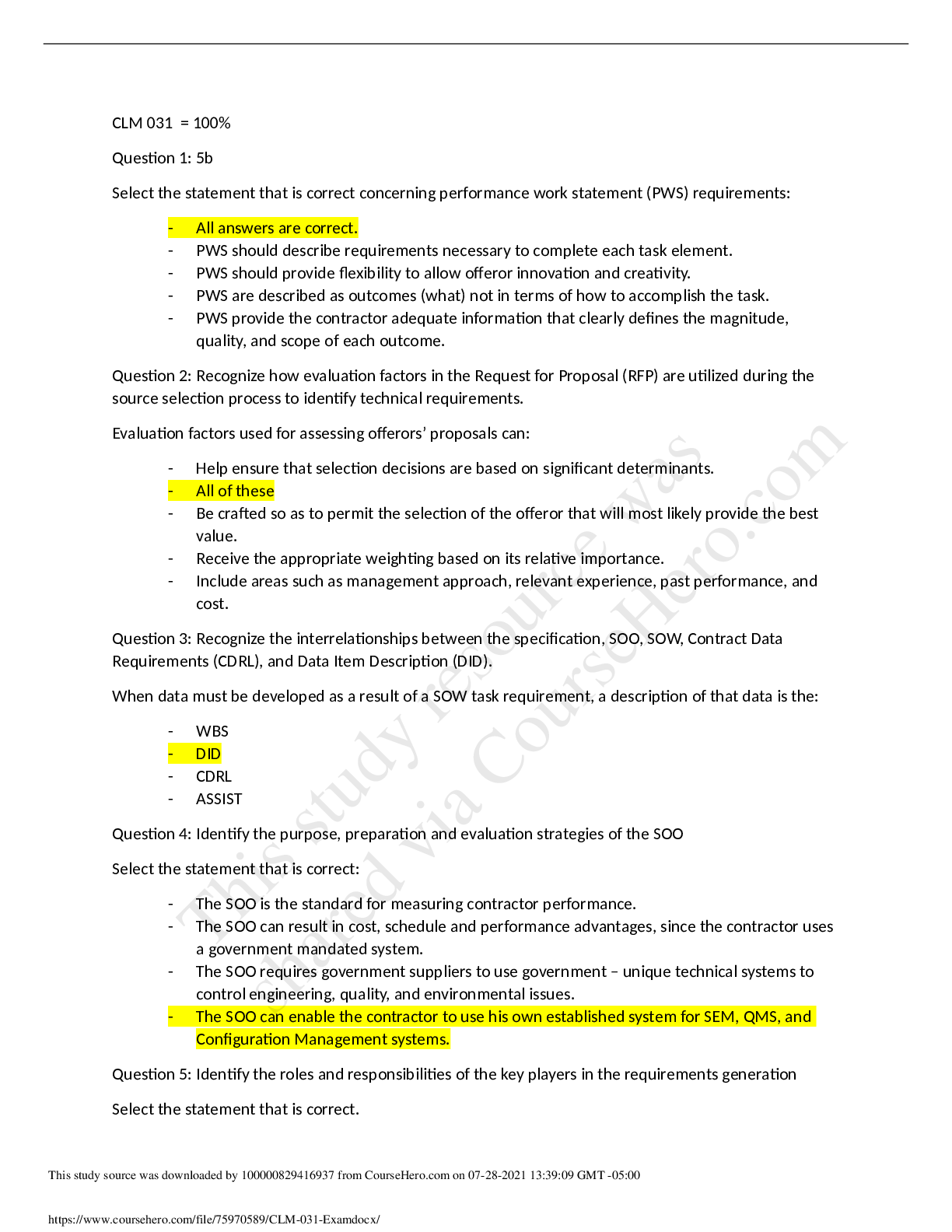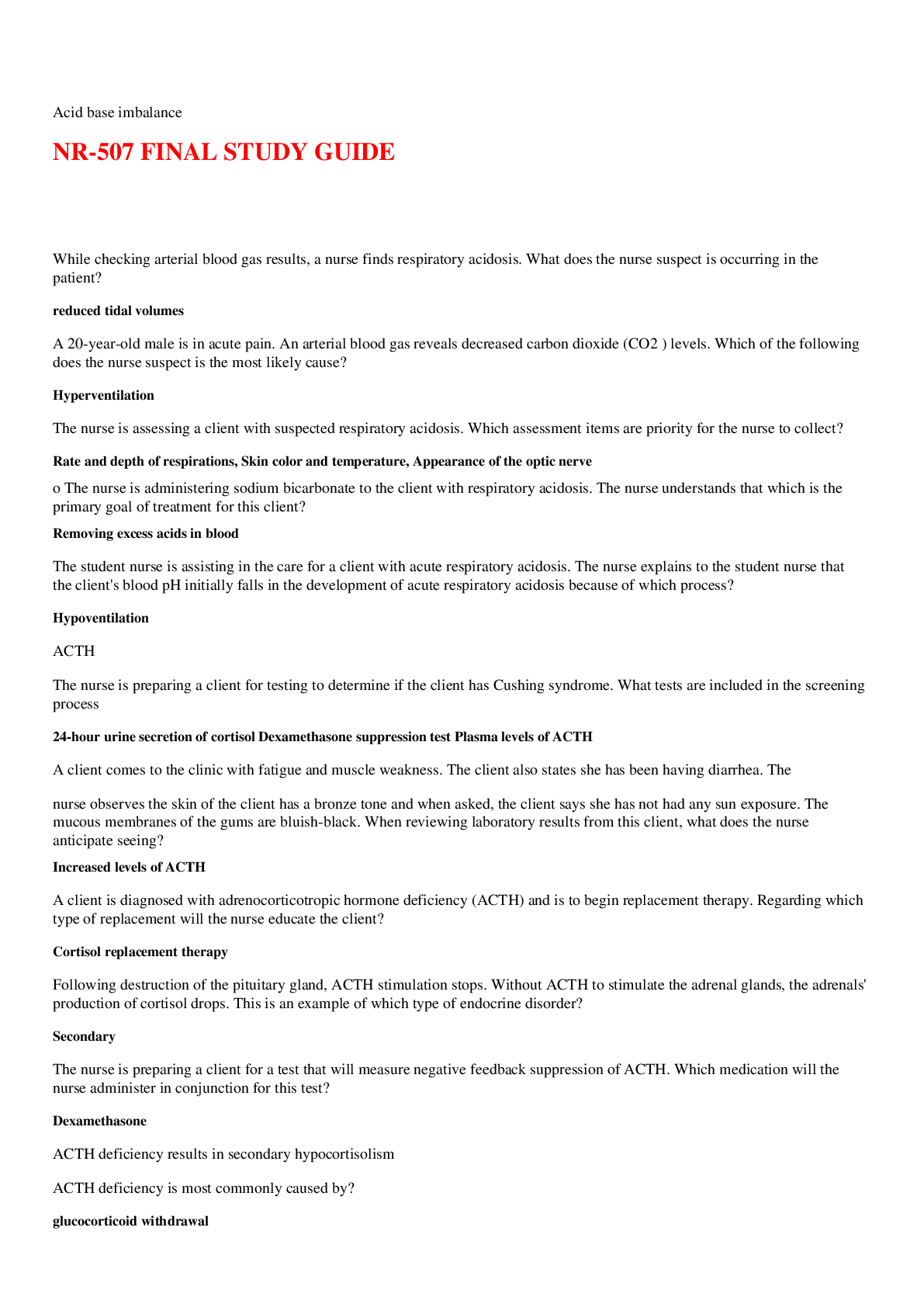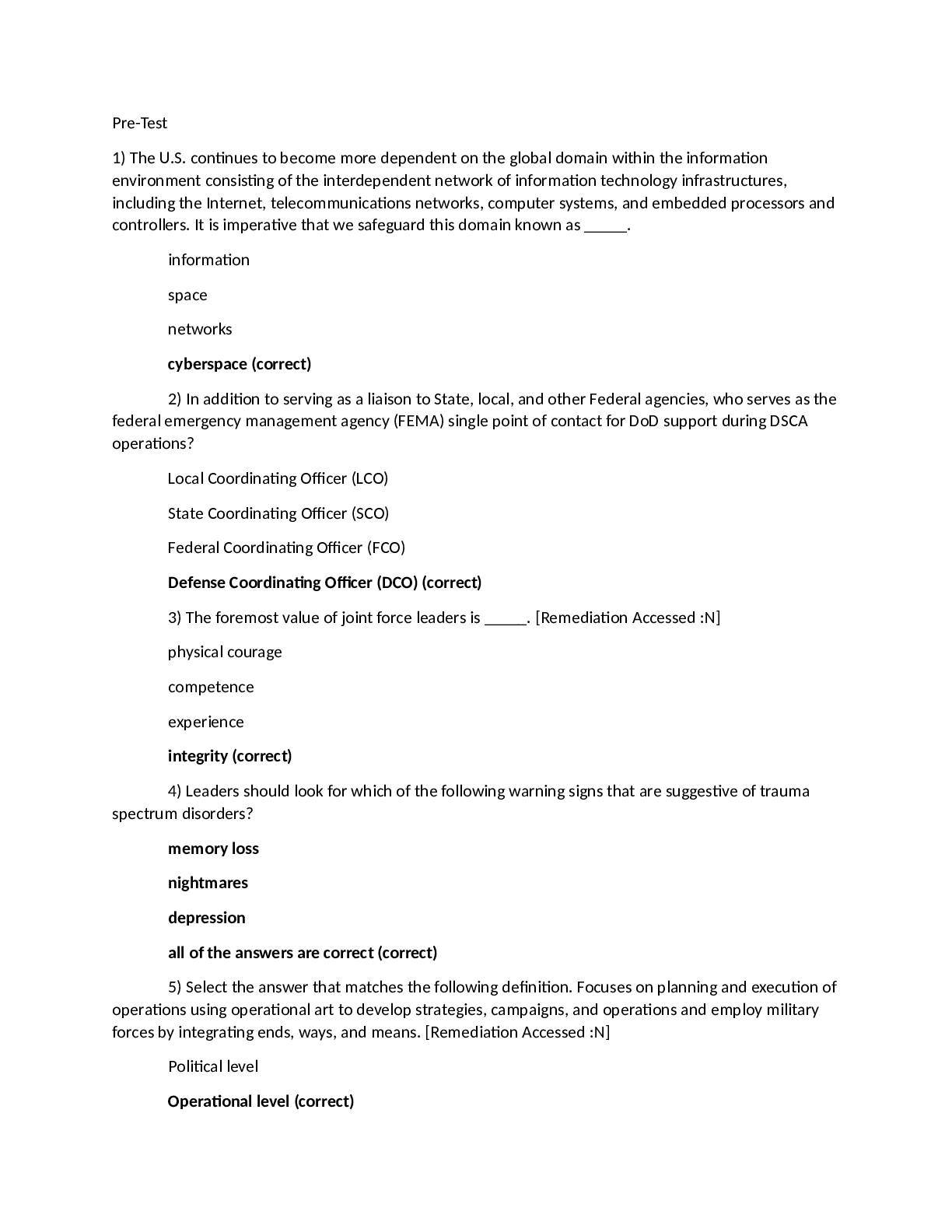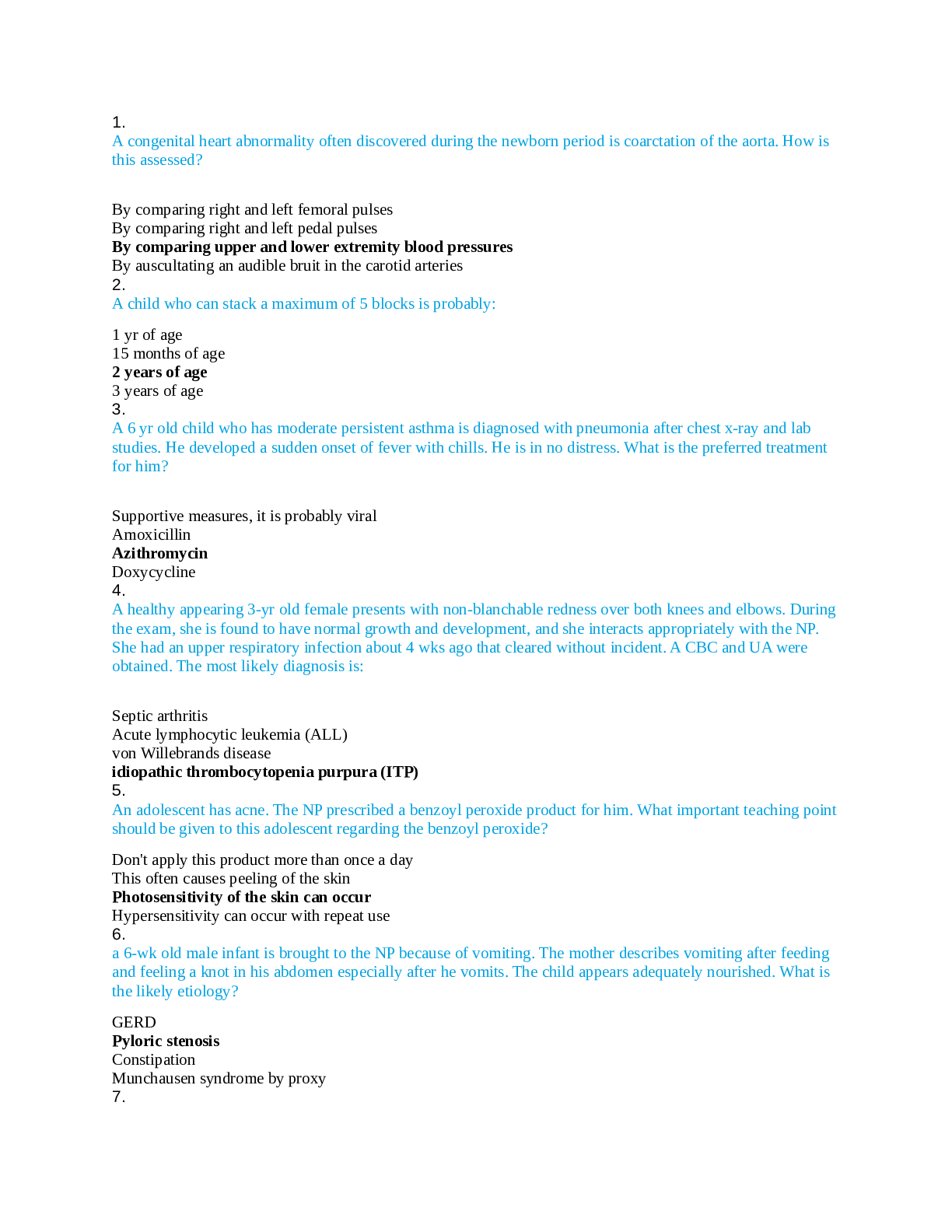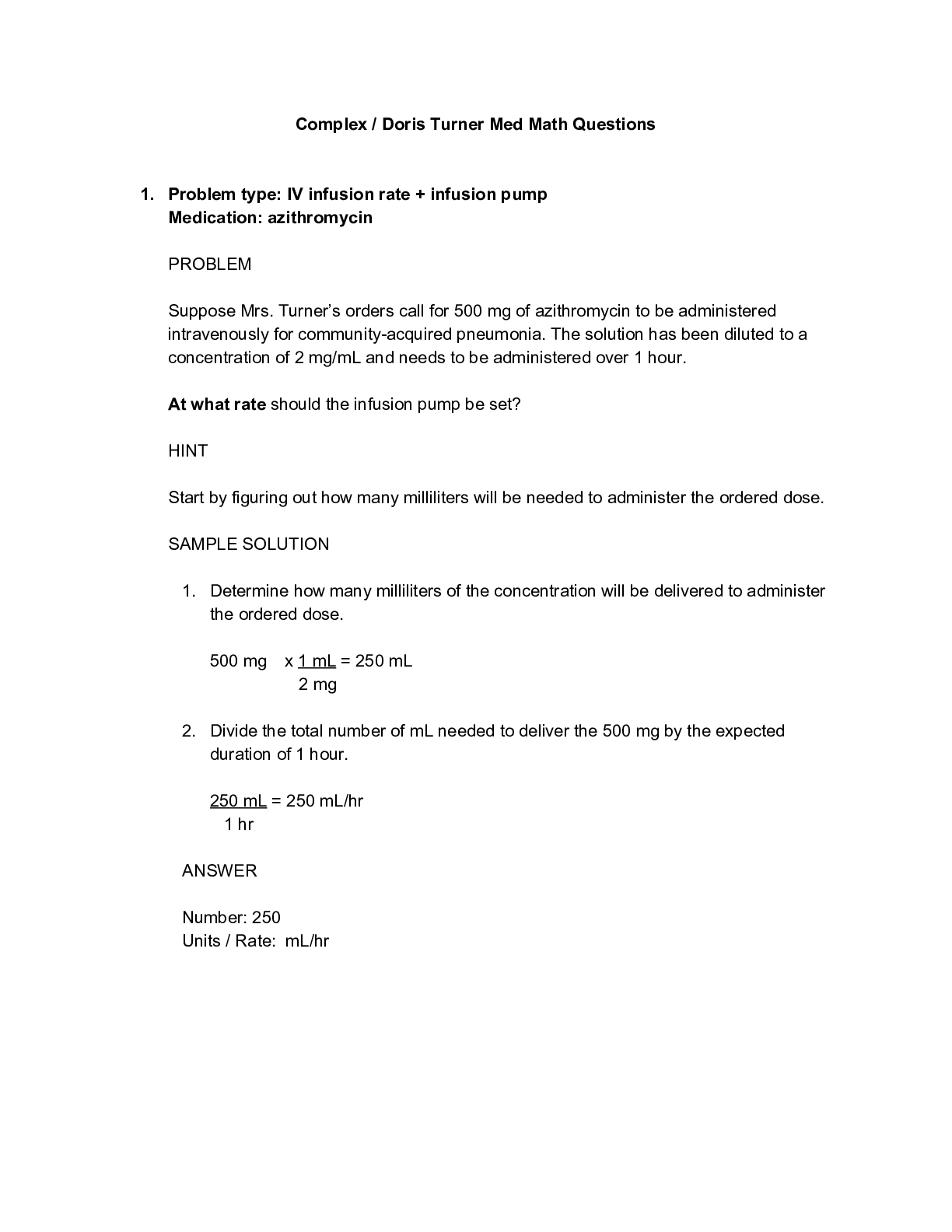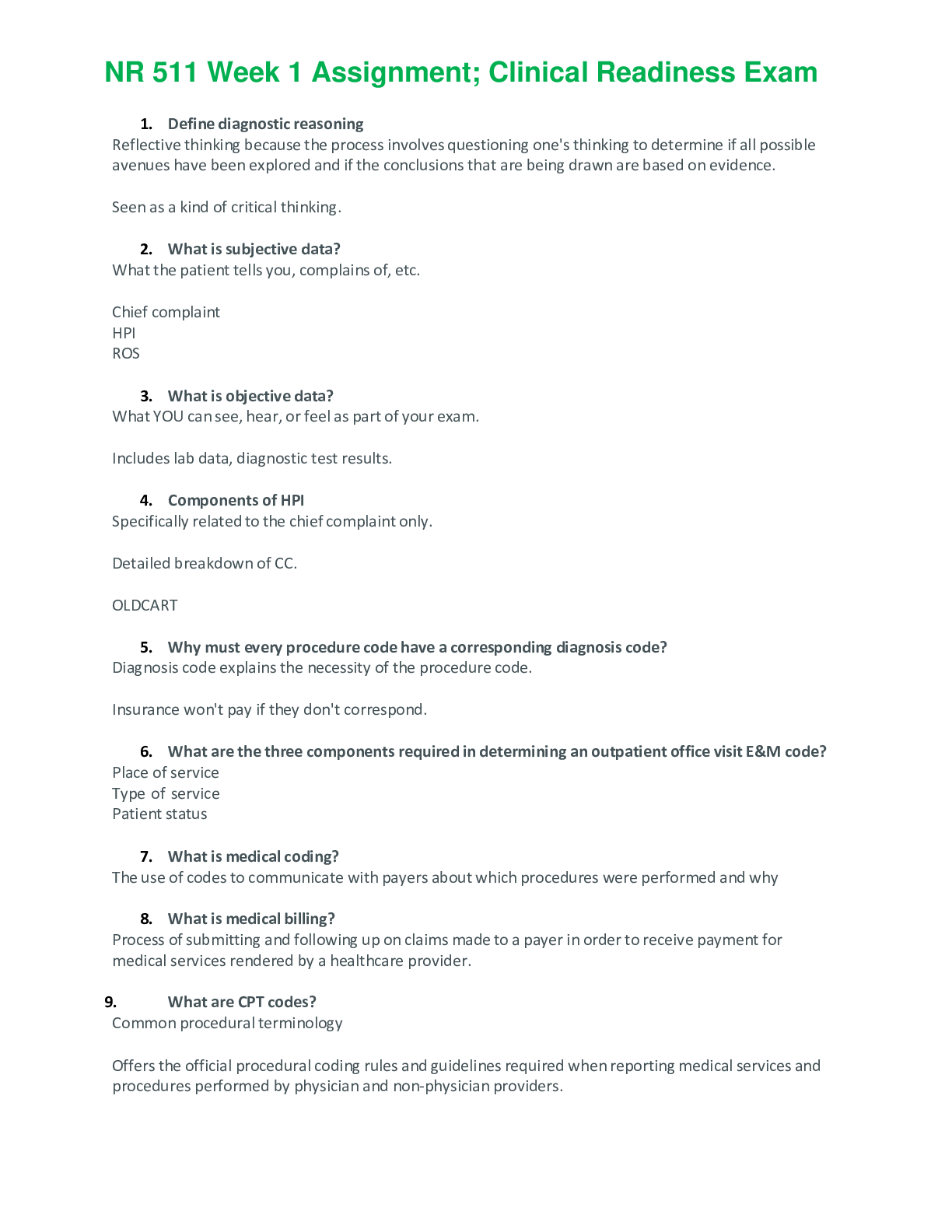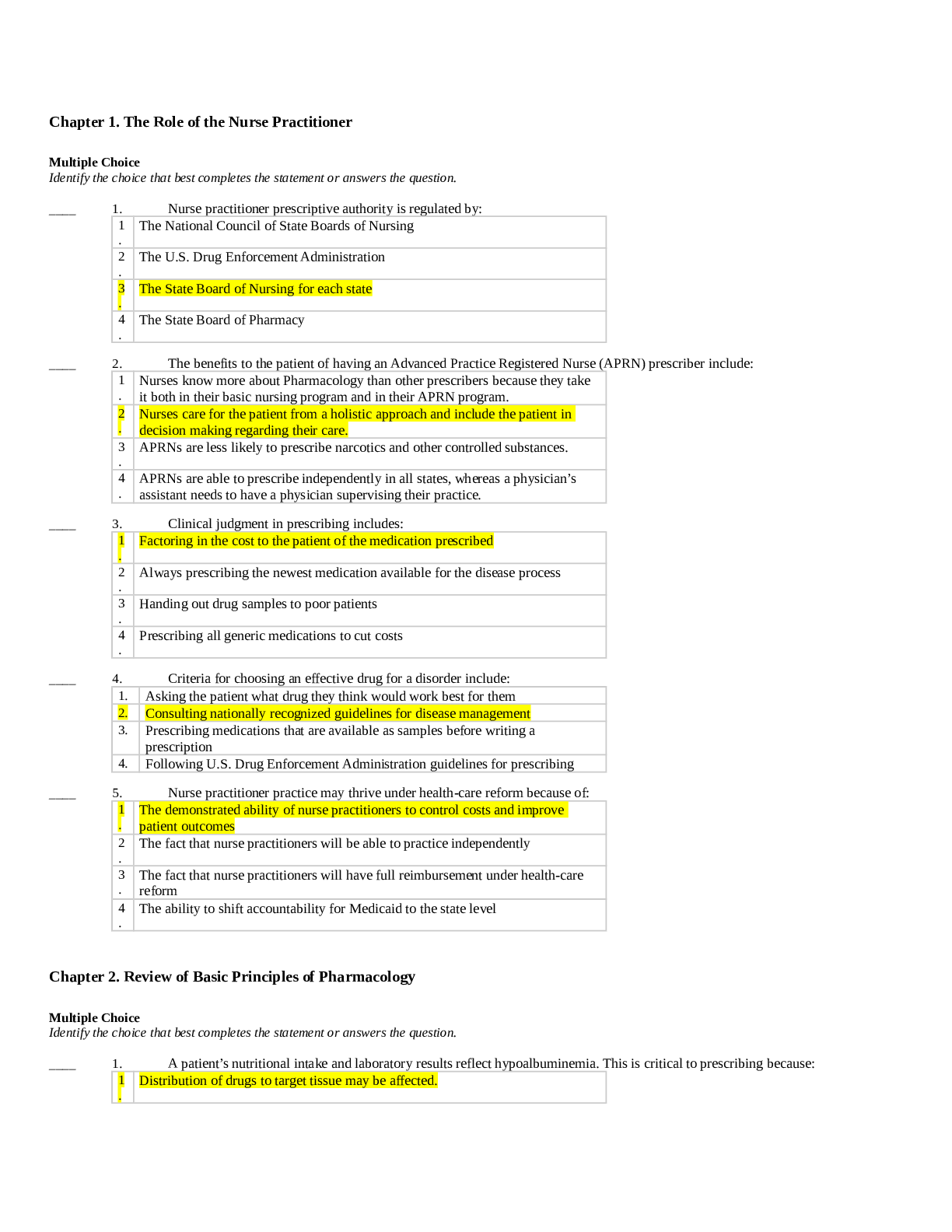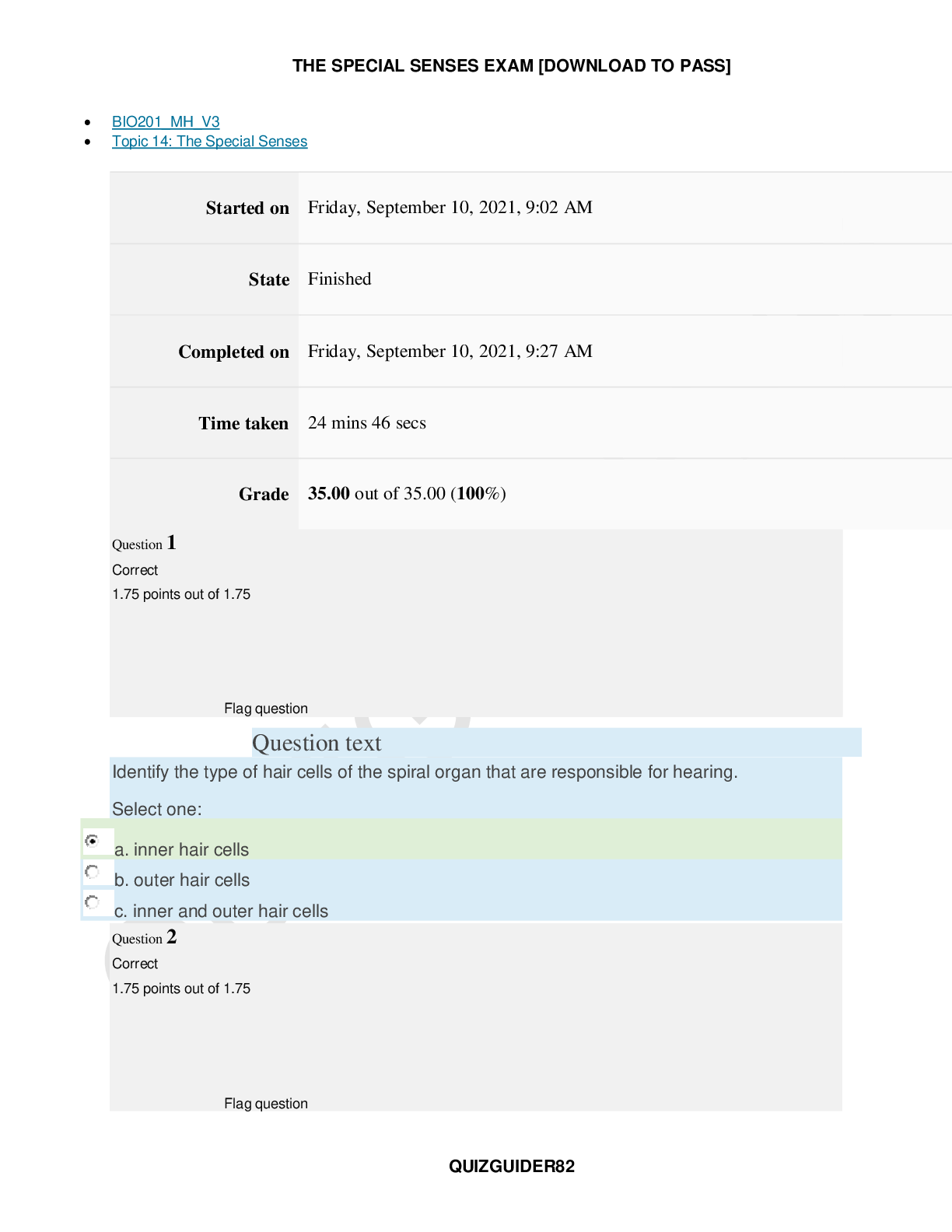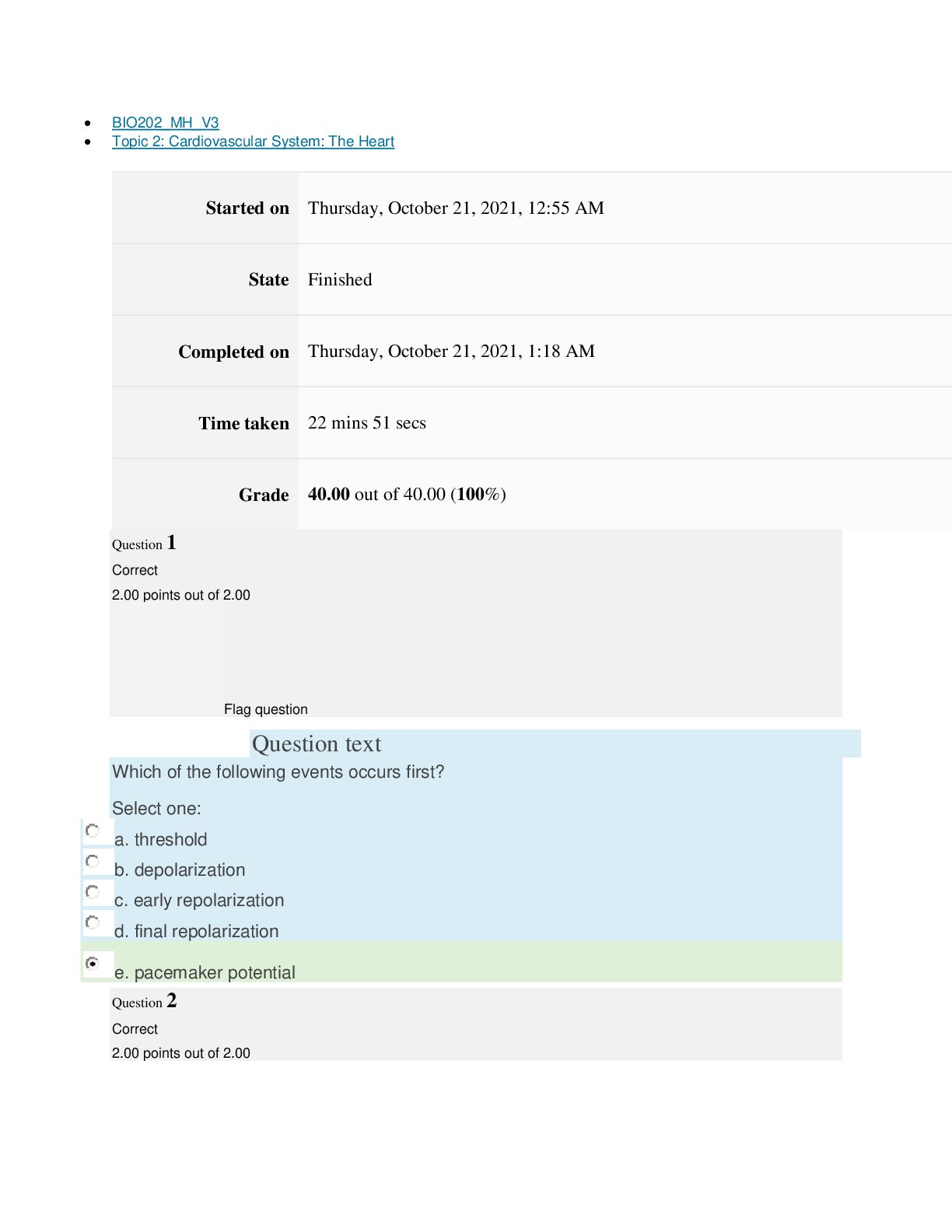Biology > QUESTIONS & ANSWERS > BIO202_MH_V3: Digestive System (GRADED A+) PERFECT REVISION TOOL (All)
BIO202_MH_V3: Digestive System (GRADED A+) PERFECT REVISION TOOL
Document Content and Description Below
BIO202_MH_V3 Topic 7: Digestive System Started on Friday, October 22, 2021, 5:31 PM State Finished Completed on Friday, October 22, 2021, 6:13 PM Time taken 42 mins 7 secs Grade 175.50 o... ut of 180.00 (98%) Question 1 Correct 4.50 points out of 4.50 Flag question Question text When a person develops a sore throat, white blood cells are drawn to the area of infection by a process called Select one: a. chemotaxis. b. diapedesis. c. margination. d. ameboid movement. e. attraction. Question 2 Correct 4.50 points out of 4.50 Flag question Question text Which of the following phrases is least likely to be used in describing erythrocytes? Select one: a. biconcave cells b. cells can change shape c. cytoplasm contains hemoglobin d. nucleus is centrally located e. main role is transporting blood gases Question 3 Correct 4.50 points out of 4.50 Flag question Question text When large quantities of blood are lost, erythrocytes must be replaced to restore Select one: a. the body's ability to fight infection. b. oxygen-carrying capacity. c. thrombin levels. d. normal blood pH. e. iron levels. Question 4 Correct 4.50 points out of 4.50 Flag question Question text Which of the following cell types is an immature red blood cell? Select one: a. erythrocyte b. reticulocyte c. thrombocyte d. monocyte e. leukocyte Question 5 Correct 4.50 points out of 4.50 Flag question Question text On which chromosome is there a mutation that leads to sickle cell anemia? Select one: a. chromosome 3 b. chromosome 11 c. chromosome 14 d. chromosome 21 Question 6 Correct 4.50 points out of 4.50 Flag question Question text The total blood volume is ____ plasma. Select one: a. 50% b. 90% c. 75% d. 55% Question 7 Correct 4.50 points out of 4.50 Flag question Question text Within normal limits, an increase in preload leads to Select one: a. an increase in cardiac output and force of left ventricular contraction. b. a decrease in cardiac output and force of left ventricular contraction. c. an increase in cardiac output and a decrease in force of left ventricular contraction. d. a decrease in cardiac output and an increase in the force of left ventricular contraction. e. a decrease in stroke volume and heart rate. Question 8 Correct 4.50 points out of 4.50 Flag question Question text E.Z. Goen is admitted to the cardiac unit with a diagnosis of endocarditis. When E.Z. asks the nurse where the infection is located, the nurse replies that the infection is in Select one: a. the outer layer of the heart wall. b. the inner lining of the heart. c. a membranous sac that encloses the heart wall. d. the muscular layer of the heart. e. the lining of the mediastinum. Question 9 Correct 4.50 points out of 4.50 Flag question Question text If the heart receives more sympathetic stimulation than parasympathetic stimulation, the heart will Select one: a. increase its rate and force of contraction. b. contract with greater force but at a slower rate. c. decrease both its rate and force of contraction. d. contract with less force but at a faster rate. e. decrease rate, but increase force of contraction. Question 10 Correct 4.50 points out of 4.50 Flag question Question text During hemorrhagic shock in which blood pressure is decreased, which of the regulatory mechanisms is most important is increasing cardiac output to help maintain blood pressure? Select one: a. increased sympathetic stimulation of the heart b. increase venous return c. increase in parasympathetic stimulation of the heart d. increase vagal stimulation of the heart e. increase in the amplitude of the heart sounds Question 11 Correct 4.50 points out of 4.50 Flag question Question text What abnormal heart rhythm could be caused by an elevated body temperature, excessive sympathetic stimulation, or toxic conditions? Select one: a. bradycardia b. atrial fibrillation c. second-degree AV node block d. tachycardia Question 12 Correct 4.50 points out of 4.50 Flag question Question text Angina pectoris is chest pain caused by reduced Select one: a. stimulation of the myocardium. b. blood supply to cardiac muscle. c. fluid in the pericardial sac. d. contractility of the heart. e. action potentials from SA node. Question 13 Correct 4.50 points out of 4.50 Flag question Question text Which of the following happens when a person stands in one place for a long period of time? Select one: a. Gravity causes an increased accumulation of blood in the veins in the feet and legs. b. Blood pressure rises in the venules of the feet. c. Without muscular movement the pressure at the venous end of the capillaries increases. d. Edema may occur in the lower extremities. e. All of these choices are correct. Question 14 Correct 4.50 points out of 4.50 Flag question Question text The visceral branches of the internal iliac arteries supply blood to the Select one: a. external genitalia. b. urinary bladder, rectum, and reproductive organs. c. lower leg. d. anterior abdominal wall. e. lumbar and gluteal muscles. Question 15 Correct 4.50 points out of 4.50 Flag question Question text Which kind of vessel provides a bypass for a capillary bed? Select one: a. sinusoid b. portal vein c. thoroughfare channel d. vasa vasorum e. metarteriole Question 16 Correct 4.50 points out of 4.50 Flag question Question text In a capillary bed, relaxation of the precapillary sphincter Select one: a. causes more blood flow through thoroughfare channels. b. causes less blood to flow through capillaries. c. occurs when the tissue in the area does not need more oxygen. d. is voluntary. e. occurs when the tissue in the area needs more oxygen. Question 17 Correct 4.50 points out of 4.50 Flag question Question text Case study: Dale Fremore was back home after spending the day at a picnic where he ate some "spoiled" potato salad. He developed severe abdominal pain and cramps, vomiting, and diarrhea. After about ten to twelve episodes of water diarrhea, Mr. Fremore became so pale and weak he could hardly walk. His wife took him to the hospital where he was diagnosed with severe dehydration (decreased plasma volume). Mr. Fremore was suffering from shock. The body has several mechanisms that can come into play to try to maintain blood pressure and blood flow when a person goes into shock. Urine output usually decreases when a person is in shock. This is the result of Select one: a. decreased ADH secretion. b. increased renin secretion. c. increased secretion of atrial natriuretic factor. d. decreased vasoconstriction due to the stress relaxation response. e. decreased aldosterone secretion Question 18 Correct 4.50 points out of 4.50 Flag question Question text In which of the following would you detect a weak pulse? Select one: a. hypertension b. hemorrhagic shock c. fluid excess d. increased stroke volume e. a healthy young person Question 19 Correct 4.50 points out of 4.50 Flag question Question text The white pulp of the spleen Select one: a. contains lymphocytes that can stimulate an immune response. b. filters lymph as it flows through the spleen. c. destroys defective red blood cells. d. stimulates immune responses, filter lymph, and destroys defective red blood cells. Question 20 Correct 4.50 points out of 4.50 Flag question Question text How do lymphatic capillaries differ from blood capillaries? Select one: a. Lymphatic capillaries do not have a basement membrane. b. Simple squamous epithelial cells of lymphatics overlap with loose attachments. c. Lymphatic capillaries are more permeable than blood capillaries. d. Lymphatic capillary epithelium act as one-way valves preventing movement of fluid back into interstitial spaces. e. All of the choices are ways lymphatic capillaries differ from blood capillaries. Question 21 Correct 4.50 points out of 4.50 Flag question Question text The lymphatic system is involved in Select one: a. lipid absorption from the digestive tract. b. transporting lymph from the intestines to the liver. c. maintenance of pH in the tissues. d. production of erythrocytes. e. protein metabolism. Question 22 Correct 4.50 points out of 4.50 Flag question Question text Bacteria and debris are actively removed from the lymph by _____ in the sinuses of lymph nodes. Select one: a. trabecular cells b. germinal cells c. macrophages. d. lymphocytes e. plasma cells Question 23 Correct 4.50 points out of 4.50 Flag question Question text Active natural immunity occurs when Select one: a. antibodies pass from a pregnant mother to her fetus. b. antibodies are injected into a host. c. an individual develops a disease. d. a person is vaccinated. e. antibodies are passed in breast milk. Question 24 Correct 4.50 points out of 4.50 Flag question Question text Circulatory changes that occur in inflammation include Select one: a. increased viscosity of the blood. b. decreased vascular permeability. c. increased vascular permeability. d. decreased blood flow to the area. e. vasoconstriction. Question 25 Correct 4.50 points out of 4.50 Flag question Question text Several research groups are working on vaccines that will be effective against the AIDS virus. When a successful vaccine is produced, it is likely to be injected to produce Select one: a. active natural immunity. b. active artificial immunity. c. passive natural immunity. d. passive artificial immunity. e. active passive immunity. Question 26 Correct 4.50 points out of 4.50 Flag question Question text Which of the following is NOT a function of the pseudostratified ciliated columnar epithelium of the nasal cavity? Select one: a. traps dirt and removes it from the air b. moisturizes the air c. exchanges oxygen and carbon dioxide d. warms the air Question 27 Correct 4.50 points out of 4.50 Flag question Question text Which of the following statements concerning the lungs and the pleura is true? Select one: a. Each lung is suspended in a separate pleural cavity. b. Parietal pleura covers the surface of each lung. c. The space between the visceral and parietal pleurae is called the mediastinum. d. The pleural fluid assists in gas exchange. e. The pleural membranes adhere, but cannot slide past each other. Question 28 Correct 4.50 points out of 4.50 Flag question Question text Direct stimulation of neurons within the dorsal respiratory group would cause an increase in the frequency of action potential in the Select one: a. glossopharyngeal nerve that innervates the pharyngeal muscles. b. phrenic nerve that innervates the diaphragm. c. vagus nerve that innervates the smooth muscle of the bronchioles. d. intercostal nerves to internal intercostals muscles. e. intercostal nerves to external intercostals muscles. Question 29 Correct 4.50 points out of 4.50 Flag question Question text The volume of air inspired or expired with each breath is the Select one: a. residual volume. b. inspiratory reserve volume. c. tidal volume. d. expiratory reserve volume. Question 30 Correct 4.50 points out of 4.50 Flag question Question text The Bohr effect refers to the Select one: a. mechanism involved in diffusion of nitrogen into the blood. b. physical laws governing the solubility of gases in fluids. c. effect of pH on the oxygen-hemoglobin dissociation curve. d. chemical equilibrium between carbonic acid and bicarbonate in the blood. e. effect of temperature on the oxygen-hemoglobin dissociation curve. Question 31 Incorrect 0.00 points out of 4.50 Flag question Question text Arrange the following in order from highest to lowest PO2. (1) PO2 of pulmonary veins (2) PO2 of pulmonary artery (3) PO2 of alveolar air Select one: a. 1, 2, 3 b. 2, 1, 3 c. 2, 3, 1 d. 3, 1, 2 CORRECT ANSWER e. 3, 2, 1 Question 32 Correct 4.50 points out of 4.50 Flag question Question text A patient has severe pneumonia, which has thickened the respiratory membrane. Despite oxygen therapy, he still has rapid respiration and feels as if he is not getting enough air. This is because Select one: a. the oxygen increases the stimulation of the carotid and aortic bodies. b. the oxygen stimulates the respiratory center to increase the respiratory rate. c. his blood pH increased and stimulated an increase in his respiratory rate. d. even though he is receiving enough oxygen, carbon dioxide and hydrogen ions accumulate in his blood and cause the respiratory rate to continue to increase. e. oxygen cannot diffuse across the thickened membrane. Question 33 Correct 4.50 points out of 4.50 Flag question Question text Constriction of smooth muscle in the bronchioles Select one: a. occurs during periods of exercise. b. restricts the flow of air into the lungs. c. decreases ciliary action. d. increases airflow out of the lungs. e. does not affect airflow. Question 34 Correct 4.50 points out of 4.50 Flag question Question text Which of the following is NOT an accessory organ of the digestive tract? Select one: a. esophagus b. salivary glands c. pancreas d. gallbladder Question 35 Correct 4.50 points out of 4.50 Flag question Question text The pancreatic islets Select one: a. are found in the wall of the stomach. b. excrete mucus. c. produce digestive enzymes. d. are exocrine glands. e. are endocrine glands. Question 36 Correct 4.50 points out of 4.50 Flag question Question text Which digestive activity is NOT correctly matched to its location? Select one: a. killing microorganisms with lysozyme - stomach b. digestion of carbohydrates - mouth c. absorption of nutrients - small intestine d. production of mucus - esophagus Question 37 Correct 4.50 points out of 4.50 Flag question Question text In comparison to a low-density lipoprotein (LDL), a high density lipoprotein (HDL) contains Select one: a. less lipid. b. less protein. c. more cholesterol. d. more carbohydrate. e. more amino acids. Question 38 Correct 4.50 points out of 4.50 Flag question Question text What are the two major neurotransmitters of the ENS in the digestive tract? Select one: a. epinephrine and serotonin b. epinephrine and norepinephrine c. acetylcholine and epinephrine d. norepinephrine and acetylcholine Question 39 Correct 4.50 points out of 4.50 Flag question Question text Which of the following might happen if a person begins laughing while swallowing a liquid? Select one: a. laryngeal constriction forcing liquid through the pharynx b. relaxation of the soft palate allowing liquid to enter the nasal cavity c. the tongue might be swallowed d. nothing - swallowing will be normal e. peristalsis will not begin Question 40 Correct 4.50 points out of 4.50 Flag question Question text Which of the following are effects of aging on the digestive system? Select one: a. blood supply decreases b. more likely to develop ulcerations and cancers c. enamel on teeth becomes thinner d. blood supply decreases and more likely to develop ulcerations and cancers. e. blood supply decreases, more likely to develop ulcerations and cancers and enamel on teeth becomes thinner. [Show More]
Last updated: 2 years ago
Preview 1 out of 20 pages

Buy this document to get the full access instantly
Instant Download Access after purchase
Buy NowInstant download
We Accept:

Reviews( 0 )
$10.50
Can't find what you want? Try our AI powered Search
Document information
Connected school, study & course
About the document
Uploaded On
Dec 04, 2022
Number of pages
20
Written in
Additional information
This document has been written for:
Uploaded
Dec 04, 2022
Downloads
0
Views
155



